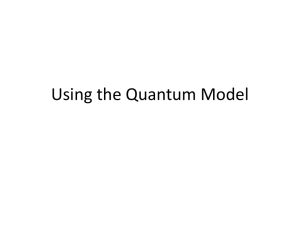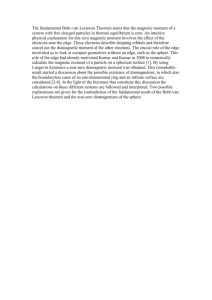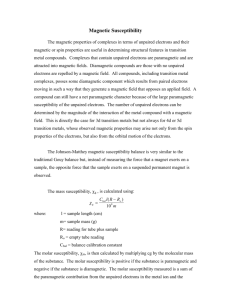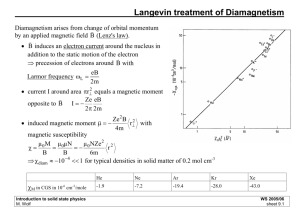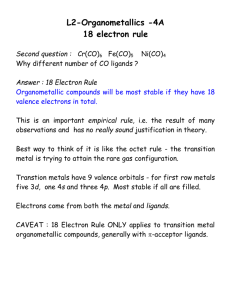Bonding in Transition Metal Compounds Oxidation States and Bonding n ns
advertisement
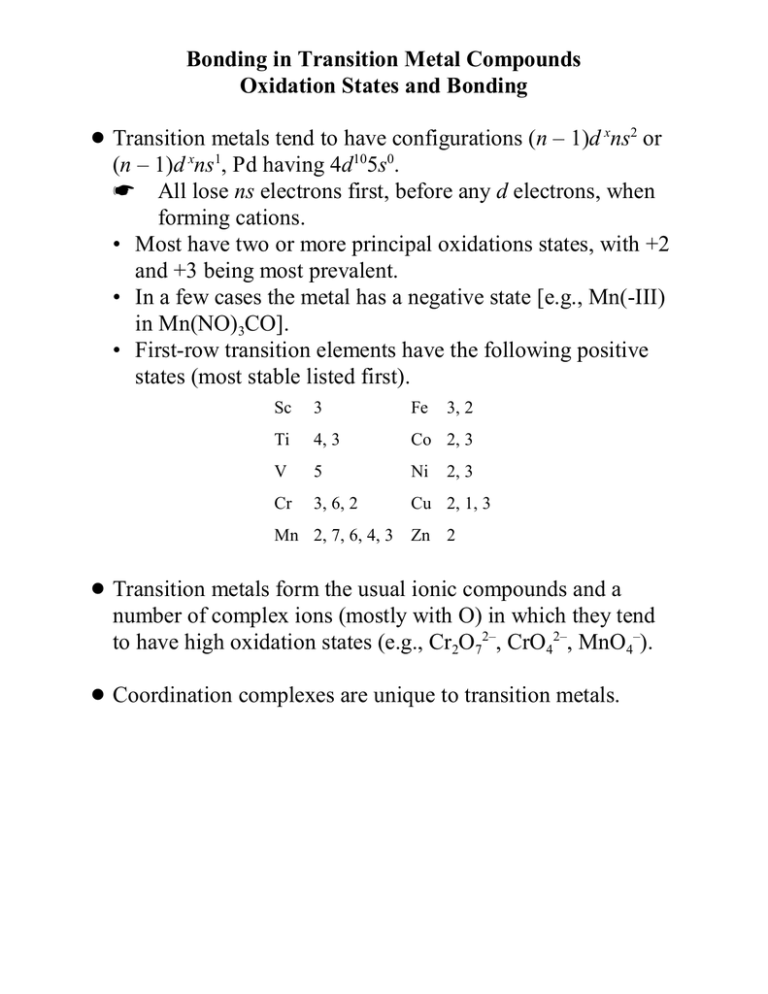
Bonding in Transition Metal Compounds
Oxidation States and Bonding
! Transition metals tend to have configurations (n – 1)d xns2 or
(n – 1)d xns1, Pd having 4d105s0.
K All lose ns electrons first, before any d electrons, when
forming cations.
• Most have two or more principal oxidations states, with +2
and +3 being most prevalent.
• In a few cases the metal has a negative state [e.g., Mn(-III)
in Mn(NO)3CO].
• First-row transition elements have the following positive
states (most stable listed first).
Sc
3
Fe
3, 2
Ti
4, 3
Co 2, 3
V
5
Ni
Cr
3, 6, 2
Cu 2, 1, 3
2, 3
Mn 2, 7, 6, 4, 3 Zn 2
! Transition metals form the usual ionic compounds and a
number of complex ions (mostly with O) in which they tend
to have high oxidation states (e.g., Cr2O72–, CrO42–, MnO4–).
! Coordination complexes are unique to transition metals.
Transition Metal Complexes
! In complexes the metal ion is surrounded by several anions or
neutral molecules (sometimes cations) called ligands.
! The coordinate bond results from the Lewis acid character of
the metal ion and Lewis base character of the ligands; e.g.,
M2+ + 6 :L º [ML6]2+
! Relative to typical covalent bonds, the M–L bonds are weak.
• Displacement of ligands by other ligands is a common
feature of transition metal complex chemistry.
ML6 + Y º ML5Y + L
! Transition metal ions in a given oxidation state generally
exhibit a characteristic coordination number (CN)
corresponding to the number of electron pairs donated by the
set of ligands.
• CN2 to CN16 are known, with CN4 and CN6 being most
common.
• CN corresponds to the number of coordination sites of the
related molecular geometry; e.g., CN4 – tetrahedral, CN5 –
trigonal bipyramidal, CN6 – octahedral.
Ligand Types
! Ligands may coordinate through one or more sites in the
coordination geometry.
! Ligands that occupy only one site are called unidentate ("one
toothed"); e.g., NH3, CN–, CO, H2O, Cl–.
! Ligands that coordinate through more than one atom and
occupy more than one coordination site are called
multidentate and may be bidentate, tridentate,
tetradridentate, etc.
• Multidentate ligands are also called chelates (k‘'@l~t – Gk.,
chela = crustacean claw).
H3C
H2C
NH2
C
M
H2C
O
HC
NH2
M
C
O
H3C
ethylenediamine (en)
acetylacetonate (acac)
C2H4 NH2
HN
M
NH2C2H4NHC2H4NHC2H4NH2
C2H4 NH2
diethylenetriamine (dien)
triethylenetetraamine
Theories of Bonding
! Theories of bonding in transition metal complexes attempt to
understand geometries, magnetic properties, color (electronic
spectra, uv/vis), and reactivity (displacement reactions,
redox).
! Four main theories have been used.
(1) Crystal Field Theory (CFT) – Assumes electrostatic
(ionic) interactions between ligands and metal ions.
• Useful for understanding magnetism and electronic
spectra.
(2) Ligand Field Theory (LFT) – Modified CFT.
• Makes empirical corrections to account for effects of
M–L orbital overlap, improving quantitative
agreement with observed spectra.
(3) Molecular Orbital (MO) Theory – Approach using M–L
general MOs.1
• Excellent quantitative agreement, but less useful in
routine qualitative discussions.
• Qualitatively equivalent CFT.
(4) Valence Bond (VB) Theory – Assumes covalent M–L
bonds formed by ligand electron donation to empty
metal hybrid orbitals.
• Popular from 1930s to 1950s.
• Useful for rationalizing magnetic properties, but
cannot account for electronic spectra.
• Offers little that cannot be covered better by other
theories.
1
Miessler & Tarr treat MO theory as part of LFT.
Magnetic Properties - Fundamental Concepts
! Every substance (except H@) exhibits diamagnetism, owing to
the behavior of paired electrons (equal numbers of " and $
spins) in an applied magnetic field.
• In a magnetic field, electron currents are induced that
create a magnetic moment in opposition to the applied field
(induced diamagnetic moment).
• The diamagnetic moment causes the material to be repelled
slightly relative to the applied field.
• If there are no unpaired electrons, this is the only effect and
the substance is said to be diamagnetic.
! If a substance contains unpaired electrons, it has a permanent
paramagnetism from the net electron spin (S) and the net
orbital angular momentum (L).
• The paramagnetic moment will align with an applied
magnetic field.
• In the applied field, both this permanent magnetic moment
and the induced diamagnetic moment exist simultaneously.
• The permanent paramagnetic moment is always stronger, so
the net effect is attraction for the applied field.
• The substance is said to be paramagnetic, despite the
presence of the weaker induced diamagnetic moment when
in an applied field.
! Ferromagnetism results from the coupling of paramagnetic
centers in a material to produce a stronger bulk magnetism.
! Antiferromagnetism results from coupling to produce a
weaker bulk magnetism.
! Paramagnetism, ferromagnetism, and antiferromagnetism are
temperature dependant.
Magnetic Moment, :
! The magnitude of the magnetic moment, :, in actual
complexes depends upon the degree of coupling of spin and
orbital momenta (L-S coupling).
! For free gaseous atoms and f-block complexes, complete
coupling occurs and the magnetic moment depends upon J =
L ± S.
• Units are Bohr magnetons (B.M.), where
B.M. = eh/4Bmc
where e = electron charge, m = mass of electron.
• The constant g is the gyromagnetic ratio, the ratio of the
electron's magnetic moment to its angular momentum2,
which for a free gaseous atom is given by
! In many transition-metal complexes the ligands effectively
quench the orbital moment, and a spin-only moment results,
where g = 2.00023 for a free electron.
! Assuming g = 2.00 and n is the number of unpaired electrons
in the metal ion,
S = *Ems* = n/2
and
2
The angular momentum of the electron is given by
.
Spin-Only Moments
! From
, the expected values of :s for
transition-metal complexes with n = 1–5 unpaired electrons
are as follows.
n S :s (B.M.)
1 1/2
1.73
2
2.83
1
3 3/2
3.87
4
4.90
2
5 5/2
5.92
! In cases with half-filled and fully-filled subshells, the ground
state term is S (L = 0) and very good agreement with :s values
is expected.
• Complexes with d 5 configurations and no paired electrons
(high-spin) typically show this behavior (e.g.,
[Mn(H2O)6]2+, [Fe(H2O)6]3+).
Incomplete Orbital Quenching
! In some cases, such as Fe2+ (d 6) and Co2+ (d 7), the orbital
contribution is not fully quenched but remains decoupled
from the spin.
• If the full orbital momentum contribution occurs, the
moment is
but because g = 2.00
• This behavior, to some degree, is typical of ions with D or
F free-ion ground state terms.
K
If L > 0, :obs > :s is to be expected.
Determining Magnetic Moment
! Magnetic moment is not directly measured, but rather the
magnetic susceptibility, P, is observed.
! In the Gouy balance method, the behavior of a sample and
reference are compared, both in and out of an applied
magnetic field.
Analytical Balance
gold chain
.
Electromagnet
sample
! A newer version of the apparatus3 has a fixed sample with a
moveable magnet attached to a torsion balance.
3
D. F. Evans, J. Phys. E; Sci. Instr., 1974, 7, 247.
Gouy Balance Method
! The mass susceptibility, Pgs of the sample is obtained relative
to the mass susceptibility of a reference, Pgr, of known
magnetic moment, by
where W is weight out of the field (true mass) and )W is
apparent change in weight in the field resulting from
paramagnetic and diamagnetic moments.
! The experimental molar susceptibility, PM, is given by
PM = PgsM
where M is the molecular weight of the sample.
! PM includes diamagnetic contributions from electron pairs in
the metal core, ligands, and counter ions.
• The corrected molar susceptibility, PA, is
PA = PM – {PM(core) + PM(ligand) + PM(ion)}
• Values of the diamagnetic correction terms, called Pascal's
constants, can be obtained from tables of average
experimental values.4
4
G. A. Bain, J. F. Berry, J. Chem. Educ., 2008, 85, 532.
Curie-Weiss Law
! The relationship between PA and : is given by the CurieWeiss Law.
where N = Avogadro's number
$ = Bohr magneton
k = Boltzmann constant
T = temperature in kelvin (K)
2 = Weiss constant
• 2 indicates the degree of coupling of paramagnetic centers
in the sample (i.e., ferromagnetism or antiferromagnetism).
! Substituting the constants, the Curie-Weiss Law becomes
! In the absence of coupling, ideal Curie Law behavior is
observed (2 = 0), and the simpler Curie Law equation applies:
! Units of : are Bohr magnetons (B.M.)
